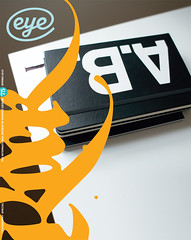Spring 2010
Toast modern
Richard Hamilton
Serpentine Gallery, London<br>3 March–25 April 2010‘Typography is more a craft than an art – the graphic designer using type will need to be something of an artist but the typographer of today is a logician whose job is to distribute given information in the most rational way possible ... The typographer’s task is clearly to present the ideas provided in the copy with sympathy and understanding. The best of typographers attempt no more, nor need they.’ – Richard Hamilton, 1961
This quote sounds as though Hamilton is talking about graphic designers when in fact he is discussing the work of an artist (Dieter Roth). This ability to see the principles of one field in another, and, perhaps more importantly, understand the complex way they interrelate, is typical of Hamilton. No other modern artist would have devoted so much time to typographically translating the work of their mentor (Marcel Duchamp, see Eye 38) and then ensured this activity was perceived as an integral part of his practice. Perhaps this explains why Hamilton has been more highly regarded by designers than other artists.
Hamilton’s interest in the graphic should not be misunderstood or even taken at face value. There are many complex thought processes underpinning his engagement with both product design and graphic design. But his sensitivity to design only really makes sense when considering how the objects and images he fashioned were always contextualised within the art world.
Toaster (1967, see p.81) is the first of several prints by Hamilton that use a particular instance of design – rather than a collage of many, as with his earlier works – as a starting point. Here, a photograph of a toaster designed by Dieter Rams for Braun is set against an abstract background, printed by offset lithography. Both the toaster and the text running beneath its image are screenprinted. Metalised polyester is collaged between the toaster’s black plastic ends. Hamilton replaced the manufacturer’s logo on one end of the toaster with his own name, in lowercase letters.
Using the same type set as Braun, he then adapted text from its advertising brochures: ‘New, practical, outstanding, this print was made possible by a number of fresh ideas. The proof of the excellence of the toaster that inspired this work of art has been supplied by the results of several endurance tests recently performed .... [The Toaster] has been included among the most attractive objects for everyday use exhibited at the New York Museum of Modern Art – the only automatic toaster in the world to achieve this honour.’
This self-conscious parody of advertising language, contained within his print, is a clever ploy. Hamilton is playing on the way modern painters styled their signatures so that the signature itself served the same office as a logo. In this case, the Braun logo was carefully designed to reflect the design ethos of the brand. By conflating the one with the other Hamilton is making a statement about not only the art market – the late 1960s witnessed the first real art boom as art became a commodity – but also the Pop Artists whose work took the commodity for subject matter.
This approach also allows Hamilton to develop further the ideas of his mentor: Duchamp, and specifically his idea of the readymade. Rather than the toaster being used as a readymade, the device through which it is visually communicated, the advertisement, is what is appropriated and then adopted (or ‘assisted’, to use the correct Duchampian term). A recent reworking of the piece occurred in 2008, with a new series premised on the earlier one. This includes Toaster Deluxe Deconstructed and Toaster Deluxe AP1. It is partly Hamilton’s ability to layer an image and partly the choices he makes in the first place that render his work so judicious and relevant today.
For further evidence of this, see Richard Hamilton, a critical reader edited by Hal Foster, which is being published under the October umbrella by MIT Press in March 2010 (£14.95). Contributors include Hamilton himself, Greil Marcus, Sarat Maharaj and Stephen Bann.
First published in Eye no. 75 vol. 19 2010
Eye is the world’s most beautiful and collectable graphic design journal, published quarterly for professional designers, students and anyone interested in critical, informed writing about graphic design and visual culture. It is available from all good design bookshops and online at the Eye shop, where you can buy subscriptions and single issues.

